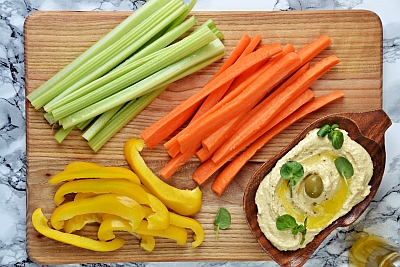Just when your family seems to get the hang of the school year, cold weather sets in. And all that quality time spent indoors tends to bring about coughs, stuffy noses, and other not-so-fun symptoms.
Kids are naturals at spreading germs, especially at school. So, we wanted to know: What can parents do to help their children fend off these back-to-school bugs? For answers, we huddled with Lauren Whitman (pictured), an Aramark Registered Dietitian Nutritionist in the Chicago Public School System.

Before getting started, Lauren reminds us that visiting your family’s pediatrician is something to do before your kids get sick. Schedule all recommended “well visits” with your doctor to be sure that they’re ready for the cold and flu season.
Lauren also shared some tricks and tips for what you can do to help fortify your kids against the seemingly inevitable season of coughs and colds. While there’s no foolproof way to fight off germs, she recommends a two-pronged approach: proper nutrition and good hygiene. Read on to learn how these healthy habits can make a world of difference in the classroom.
STRATEGY 1: PRACTICE PROPER NUTRITION
“A strong immune system relies on good nutrition,” Lauren tells us. “A well-rounded diet will boost your student’s immunity and help keep them healthy.”
She points to diets packed with fruits, vegetables, whole grains, lean protein, low-fat dairy, and healthy fats. Together these foods provide your family with the nutrients they need—antioxidants especially—for good immunity.
Here we break down the top nutrients for staying well, where to find them, and recipes featuring these good-for-you foods. “This list is by no means complete, but it’s a great place to start,” Lauren says.

The Good Stuff: Vitamin B
Where to Find It: Lean proteins like chicken, salmon, tuna, and chickpeas.
Recipes to Try: Dilled Salmon Cakes, Chicken Avocado Salad Wrap
The Good Stuff: Vitamin C (“This is a heavy-hitter when it comes to keeping your immune system in tip-top shape,” says Lauren.)
Where to Find It: Oranges, grapefruits, tangerines, clementines, strawberries, raspberries, blueberries, cranberries, bell peppers, spinach, kale, broccoli
Recipes to Try: Tropical Green Smoothie, Grilled Vegetable Pizza
The Good Stuff: Vitamin D
Where to Find It: “Yogurt is a hero here! Fortified yogurt contains vitamin D and calcium, both of which are important for strong bone health at every age,” Lauren explains.
Recipes to Try: Strawberry Chia Toast, Yogurt Herb Ranch Dressing
(to dip all those veggies!)
The Good Stuff: Vitamin E
Where to Find It: Nuts like almonds, seeds like sunflower seeds, olive oil and spinach.
Recipes to Try: Spinach Pasta Toss, Spinach-Feta Spread
The Good Stuff: Minerals such as zinc, iron, folic acid and selenium
Where to Find It: Lean meats and whole grains are just two of many foods rich in these minerals, which have been found to help immune systems stay strong.
Recipes to Try: Overnight Apple N’ Oats, Roasted Butternut Tartine
Now that you’ve stocked up on these healthy choices, you want your children to actually eat and enjoy them. Lauren has a few tips for making this a breeze:

- Make it convenient. “Children are more likely to reach for produce if it is quick and easy,” Lauren advises. Cut up fruit and veggies ahead of time or buy ready-to-eat foods like baby carrots, bananas and oranges. Keep them at eye-level in the fridge or on the kitchen counter.
- Give them a vote. Your students will be more likely to eat meals they have a say in. Let them choose the veggie side for tonight’s dinner (green beans or broccoli?)—then assign an age-appropriate task during meal prep.
- Strike a balance. Encourage them to fill half their plate with fruits and veggies—that way, you know they are getting enough of the good stuff. “You can be more flexible with the rest, but don’t offer too many foods high in calories from sugar and saturated fat.,” says Lauren.
- Health-ify their favorites. Add a few veggies to dishes your child already loves for an added dose of nutrition. Try a handful of spinach in their mac-and-cheese or red peppers on pizza.
- Always keep them hydrated. While quenching your thirst in the summer heat is a no-brainer, hydration is important for your students optimal health all winter. If they typically ask for drinks with flavor, hot or iced antioxidant-rich teas can be a great addition to water.
STRATEGY 2: KEEP IT CLEAN (AND HEALTHY)
A solid diet will give your children a strong foundation, but that doesn’t change the fact that schools packed with kids can be, well, germy places. “When your child enters the classroom, they are exposed to more viruses and bacteria than at home,” Lauren explains. “From their desks to the lunchroom to the playground, students spend a lot of time in close quarters—and that’s how sickness spreads.”
This is where healthy routines can make all the difference. It’s never too early to teach your children the following habits to protect them from germs at home, at school, and beyond.
Healthy Habits

- Wash your hands often. Hear this one all the time? That’s because it works! Wash your hands before and after meals, after playing in the dirt or with pets, and after being around someone who is sick. For how long? Long enough to sing, “Happy Birthday” twice through. “Use soap and warm water,” Lauren reminds us. “Hand sanitizers aren’t as effective but work in a pinch.”
- Try not to touch your face, especially your eyes, nose, and mouth. This is how germs get into our bodies and make us sick. Combine this with regular hand-washing, and germs won’t stand much of a chance.
- Don’t share food and drinks. Discourage children from eating and drinking from the same containers as their friends. Sharing straws, cups, utensils—or even reaching into the same bag of food—can spread germs all too easily.
- Stay active after school. Regular exercise is key for a strong immune system—so make sure to keep moving. On nights when the kids don’t have sports practice or some kind of physical activity during the day, try to do something active as a family. “Busy families may not have much time to spare, so fit in what you can. Every bit helps,” encourages Lauren.
- Get plenty of sleep. According to the American Academy of Pediatrics, your preschooler should get 10 to 13 hours of sleep each day (including naps). School-age children from 6 to 12 years need between 9 and 12 hours each night, while teens should aim for 8 to 10 hours. Set an after-school schedule to keep bedtimes consistent throughout the week. And turn off those screens at least an hour before bed—this will help them fall asleep more easily.
Study up on these smart habits, and your child will be a step ahead of classroom germs. Still, even the healthiest kids come down with a bug from time to time. When this happens, a sick day or two may be in order, to rest and recover and keep the germs from spreading to friends and classmates.
Check out our Recipe page for other dishes filled with the nutrients needed for the fall and winter season and all year long. We add new recipe ideas every month!
Note: Since everyone’s health history and nutritional needs are so different, please make sure that you talk with your doctor and a registered dietitian to get advice about the diet and exercise plan that‘s right for you.

